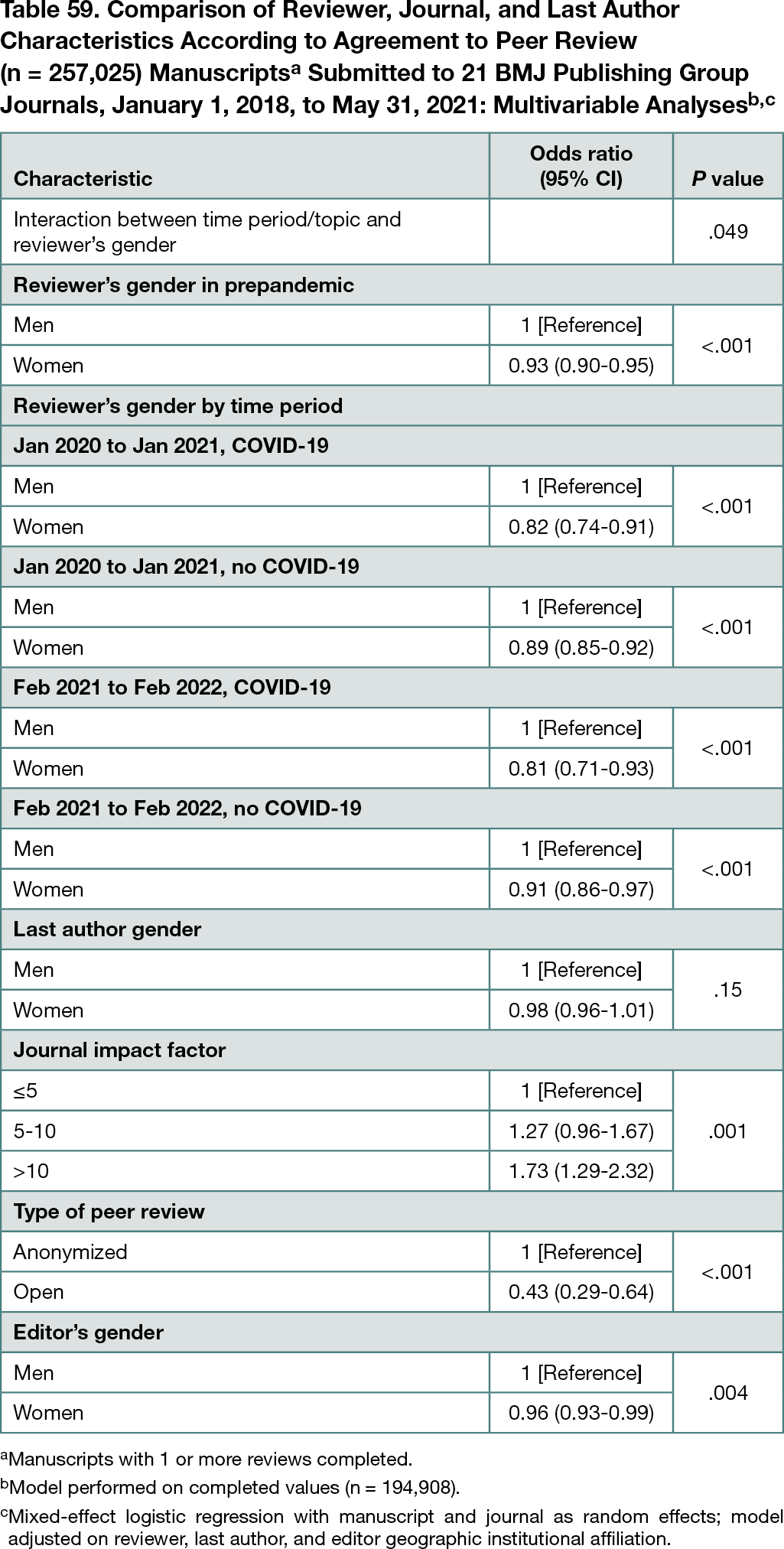Abstract
Women’s Responses to Peer Review Invitations by 21 Biomedical Journals Prior to and During the COVID-19 Pandemic
Khaoula Ben Messaoud,1,2 Sara Schroter,3 Mark Richards,4 Angèle Gayet-Ageron1,2
Objective
Gender disparities have been shown to have increased during the COVID-19 pandemic at several levels in the research process, including in the submission and publication of biomedical research articles.1-3 One study also reported an increase in the rate of women declining invitations to peer review biomedical research in the very early pandemic period.3 However, women’s response to peer review invitations during the longer term of the COVID-19 pandemic remains unknown. In this study, response to peer review invitations was explored using later COVID-19 data.
Design
This was a retrospective cohort study of research manuscripts submitted to and sent for peer review at 21 biomedical journals from the BMJ Publishing Group from January 1, 2018, to May 31, 2021. Data were collected on the gender and geographic affiliation of the handling editor, the reviewers, and the last author; the journal’s impact factor and peer review process (open vs anonymized); and the manuscript topic (COVID-19−related or not).1 The primary outcome was response (agreed vs did not agree) to the review invitation. Multivariable mixed-effects logistic regression was performed with random factors on the intercept at journal and manuscript levels.
Results
A total of 33,342 manuscripts were included; 257,025 reviewers were invited to review and 90,467 (35.2%) agreed. Mean (SD) number of invited and agreed reviewers by manuscript were 7.7 (5.6) and 2.7 (1.2), respectively. Multivariable analysis showed that agreement to review was associated significantly with time period and COVID-19 as a topic (P < .001). Women agreed to review less frequently than men at any time period or COVD-19−related topic: odds ratios, 0.93 (95% CI, 0.90-0.95) in prepandemic, 0.82 (95% CI, 0.74-0.91) in January 2020 to January 2021 for COVID-19−related manuscripts, 0.89 (95% CI, 0.85-0.92) in January 2020 to January 2021 for non-COVID-19−related manuscripts, 0.81 (95% CI, 0.71-0.93) in February 2021 to February 2022 for COVID-19−related manuscripts, and 0.91 (95% CI, 0.86-0.97) in February 2021 to February 2022 for non−COVID-19−related manuscripts. Interaction between reviewers’ gender, time period, or COVID-19 topic and agreement to review was significant (P = .049). Women agreed significantly less often than men to review COVID-19−related manuscripts during the first year of the pandemic compared with the prepandemic period. Agreement to review was lower when the handling editor was a woman compared with a man: odds ratio, 0.96 (95% CI, 0.93-0.99) (Table 59).
Conclusions
For both women and men reviewers, agreement to peer review was higher for COVID-19−related manuscripts compared with the prepandemic period. However, the representativeness of women researchers among invited reviewers was below parity. Moreover, women refused more frequently than men to participate in peer review. More generally, women’s points of views need to be fostered to have diverse vision in research. Editors should ensure a fair parity in the invitation to peer review or increase the proportion of women invited to be able to obtain parity during peer review.
References
1. Gayet-Ageron A, Ben Messaoud K, Richards M, Schroter S. Women authorship of COVID-19 research in manuscripts submitted to 11 biomedical journals: cross sectional study. BMJ. 2021;375:n2288.
2. Larivière V, Ni C, Gingras Y, Cronin B, Sugimoto CR. Bibliometrics: global gender disparities in science. Nature. 2013;504(7479):211-3.
3. Squazzoni F, Bravo G, Grimaldo F, García-Costa D, Farjam M, Mehmani B. Gender gap in journal submissions and peer review during the first wave of the COVID-19 pandemic: a study on 2329 Elsevier journals. PLOS ONE. 2021;16(10):e0257919.
1Department of Health and Community Medicine, University of Geneva, Geneva, Switzerland, khaoula.benmessaoud@unige.ch; 2Division of Clinical Epidemiology, University Hospitals of Geneva, Geneva, Switzerland; 3The BMJ, London, UK; 4Article Transfer Service, BMJ Publishing Group, London, UK
Conflict of Interest Disclosures
The authors declare support from the University Hospitals of Geneva, Geneva Medical School, and the Swiss National Science Foundation for the submitted work. Sara Schroter and Mark Richards are employees of the BMJ Publishing Group. No other disclosures were reported.
Funding/Support
This study was supported by a grant from the Swiss National Science Foundation (No. 192374).
Role of the Funder/Sponsor
The funder had no role in considering the study design or in the collection, analysis, or interpretation of data; the writing of the abstract; or the decision to submit the abstract for presentation.

